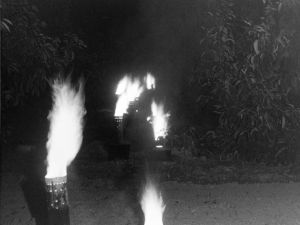http://www.ocregister.com/news/pots-226935-growers-smudging.html
January 05, 2010 8:16 AM
Smudge pots were a necessity for early growers
BY JUANITA LOVRET
COLUMNIST
Back in the days when Tustin was a valuable citrus producing area, growers worried that January's cold, cloudless, windless nights would bring freezing temperatures to damage the trees as well as the fruit.
The method used to keep the orchards warm was a refinement of the practice of burning brush and tree trimmings, which began back in the late 1880s. By 1910 growers were using smoke created by burning fuel oil.
 Smudge pots, which burned coke, a dry fuel
Smudge pots, which burned coke, a dry fuel
distilled from coal or oil, were lit in the citrus
orchards when the temperatures fell to 28 degrees
or lower. The warmth of the smoke helped to keep
the trees and fruit from freezing.
PHOTO COURTESY TUSTIN AREA HISTORICAL SOCIETY
The smudge pots they eventually used to line the aisles between the trees looked like so many upside down mushrooms. Each pot had a squatty, sheet-metal base, about 24 inches in diameter and 12 inches deep, with a removable chimney about two feet high.
In anticipation of the temperature dropping to 28 degrees or lower, workers had filled the pots with coke, a fuel with high carbon content distilled from coal or oil. Each pot held enough coke to provide eight hours of warmth.
Growers made sure that they never missed the nightly frost broadcast during the winter months. With this as a warning, they were prepared to go into action when the siren atop the First National Bank building sounded to announce the temperature drop.
Workers, usually hired hands and high school boys, used this siren as a signal to report for duty. Bundled against the cold in boots, heavy jackets and hats, they would trudge through the rows, lighting each pot with a torch. The rest of the night was spent watching the thermometer and checking the pots.
In the late '30s some growers replaced smudge pots with oil reservoirs and pumping systems that carried fuel to burners located permanently between the trees.
Although this eliminated the job of refilling the pots with coke after they had burned all night, each burner still had to be ignited. Wind machines and huge propellers, which towered high about the orchards on steel legs, came later. Requiring less labor, these devices prevented frost by providing air circulation.
The orchards glowed with an eerie orange light during a night of smudging. A veil of greasy, dark smoke hovered over the trees and as far as the eye could see when it grew light.
Anyone venturing outside, including kids waiting for the school bus or walking to school, soon had black-rimmed nostrils. Holding a handkerchief or scarf over the mouth and nose helped a little.
Housewives detested smudging. Efforts to keep the sooty mess out of the house were futile. White curtains turned dingy, piano keys yellowed, oil film settled on all surfaces. Floors were discolored as shoes carried in the soot.
The dirty air created by smudging did not readily disperse. Even if temperatures remained above freezing in Tustin, the results of smudging in orchards in Placentia, Fullerton, Anaheim and as far away as Pomona would drift in as the day advanced. This would be considered a health problem today, but at the time it was accepted as part of the process of growing oranges.
Smudging was neither cheap nor 100 percent effective. After paying fuel and labor expenses, a grower could still have a damaged crop and lost income. Citrus growers debated the value of trying to keep the orchard warm, but there was always the hope that this would be the year that the fruit survived the cold.




